Monday: Across the border to Lome, Togo.
Tammy had been telling us "if you think it's bad in Ghana, just wait until we get to Togo." Hmm.
Our first leg of the journey to Tsevie took us to Lome, Togo, which is right at the border. We are sort of used to tro-tro travel in west Africa by now, and I don't have much to say about this particular trip, except that I had to carry my suitcase on my lap for about three hours, and it was uncomfortable.
When we got off the tro-tro, we had to walk a couple blocks to the border. The first step in the border crossing is to get your passport stamped to exit out of Ghana. We went into a pretty nice building that was the Ghana immigration quarters, where there were computers and cameras and chairs and an "officer" in an office, and filled out exit forms (real forms) from Ghana and had our passports stamped.
Then we walked across the line that was the Ghana-Togo border. Two guys in uniform were sitting at a table, a couple steps up from the street, under an awning but not in a building. These were the immigration guys for Togo. They had a huge ledger book open on the table. We were given a visa form, photocopied on regular paper, with instructions in French and English. We filled it out, using the railing to write. We were glad that I had 2 pens in my big purse. They charged us for a 7-day visa, and very carefully put these really cool lick-style stamps in the passport, carefully stamped the stamps, and carefully entered - by hand - our information in the big book.
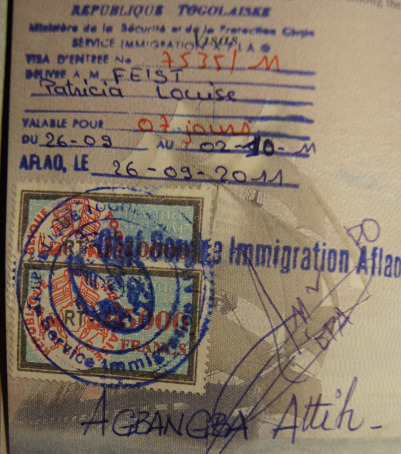
Neat stamps!
So, now we're in Togo!
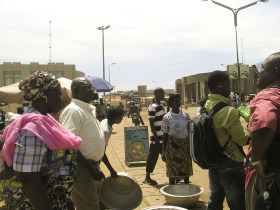
Just across the border, in Togo, looking back towards the barrier that marks the border. The large building on the right is the Ghana immigration place.
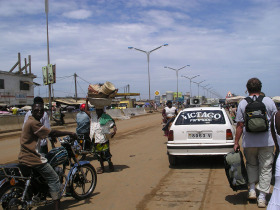
From the same spot as the previous photo, but looking in the other direction. The beach is on the right. Later on in the trip, we sat at a bar that was right on the sands of that beach. The ocean is rough and full of rip tides.
Togo is a French-speaking country. In the first half of the twentieth century, Togo was ruled by France. The populace, however, converse with each other in local languages (e.g., Ewe). French is used as the official language, and thus most Togoese are bilingual.
But John and I are not. Even though I had tried to brush up on my high school French using Rosetta Stone, I could only catch a few words here and there. We soon learned how it feels to be outside a conversation, or to not know how to negotiate a taxi because of language.
The first thing we did in Lome was take a taxi to a street-side restaurant that Tammy's been to before. We had an excellent, western-style meal. Hey, the menu's in French! But sadly, Star beer is not to be had in Togo. We make do. There was a guard in the restaurant who kept the hawkers from bothering the customers.
Lome ("low-may") is the capital of Togo. I don't feel that Togo is so much more poverty-stricken than Ghana, but maybe by this time I am just used to it. Maybe it seems a shade dirtier, a shade seemier. But it doesn't smell awful in Lome, like it did in Accra.
Traffic again is insane. In Lome, there are a lot more motos than cars. We'd see a family of four stuffed onto one moto. Motos are used as taxis, but the Peace Corps does not allow the volunteers to take them when they are in Lome because they consider them too dangerous.
I'll close this blog post with some photos of the streets of Lome, then in my next post we'll finally get to Tammy's house in Tsevie (pronounced "chev-ee-aye").
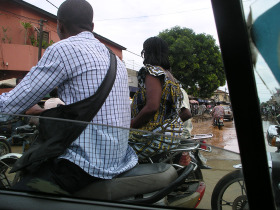
Motos on the streets of Lome, Togo. Note the moto sloshing through the rain water on the road. Tammy says in monsoon season, Lome totally floods out and all business comes to a halt. Someone we talked to said one reason it floods is that there is a ton of buried plastic bags that mess up any drainage system.
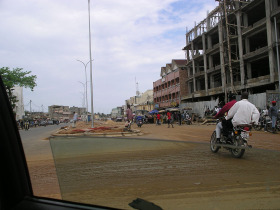
Motos on the streets of Lome, Togo.
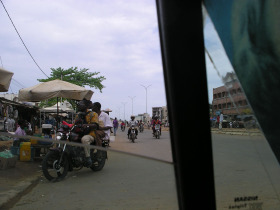
The streets of Lome.
Next post: Bush taxi.
Our first leg of the journey to Tsevie took us to Lome, Togo, which is right at the border. We are sort of used to tro-tro travel in west Africa by now, and I don't have much to say about this particular trip, except that I had to carry my suitcase on my lap for about three hours, and it was uncomfortable.
When we got off the tro-tro, we had to walk a couple blocks to the border. The first step in the border crossing is to get your passport stamped to exit out of Ghana. We went into a pretty nice building that was the Ghana immigration quarters, where there were computers and cameras and chairs and an "officer" in an office, and filled out exit forms (real forms) from Ghana and had our passports stamped.
Then we walked across the line that was the Ghana-Togo border. Two guys in uniform were sitting at a table, a couple steps up from the street, under an awning but not in a building. These were the immigration guys for Togo. They had a huge ledger book open on the table. We were given a visa form, photocopied on regular paper, with instructions in French and English. We filled it out, using the railing to write. We were glad that I had 2 pens in my big purse. They charged us for a 7-day visa, and very carefully put these really cool lick-style stamps in the passport, carefully stamped the stamps, and carefully entered - by hand - our information in the big book.

Neat stamps!
So, now we're in Togo!

Just across the border, in Togo, looking back towards the barrier that marks the border. The large building on the right is the Ghana immigration place.

From the same spot as the previous photo, but looking in the other direction. The beach is on the right. Later on in the trip, we sat at a bar that was right on the sands of that beach. The ocean is rough and full of rip tides.
Togo is a French-speaking country. In the first half of the twentieth century, Togo was ruled by France. The populace, however, converse with each other in local languages (e.g., Ewe). French is used as the official language, and thus most Togoese are bilingual.
But John and I are not. Even though I had tried to brush up on my high school French using Rosetta Stone, I could only catch a few words here and there. We soon learned how it feels to be outside a conversation, or to not know how to negotiate a taxi because of language.
The first thing we did in Lome was take a taxi to a street-side restaurant that Tammy's been to before. We had an excellent, western-style meal. Hey, the menu's in French! But sadly, Star beer is not to be had in Togo. We make do. There was a guard in the restaurant who kept the hawkers from bothering the customers.
Lome ("low-may") is the capital of Togo. I don't feel that Togo is so much more poverty-stricken than Ghana, but maybe by this time I am just used to it. Maybe it seems a shade dirtier, a shade seemier. But it doesn't smell awful in Lome, like it did in Accra.
Traffic again is insane. In Lome, there are a lot more motos than cars. We'd see a family of four stuffed onto one moto. Motos are used as taxis, but the Peace Corps does not allow the volunteers to take them when they are in Lome because they consider them too dangerous.
I'll close this blog post with some photos of the streets of Lome, then in my next post we'll finally get to Tammy's house in Tsevie (pronounced "chev-ee-aye").

Motos on the streets of Lome, Togo. Note the moto sloshing through the rain water on the road. Tammy says in monsoon season, Lome totally floods out and all business comes to a halt. Someone we talked to said one reason it floods is that there is a ton of buried plastic bags that mess up any drainage system.

Motos on the streets of Lome, Togo.

The streets of Lome.
Next post: Bush taxi.
Comments
No comments yet
Add Comment